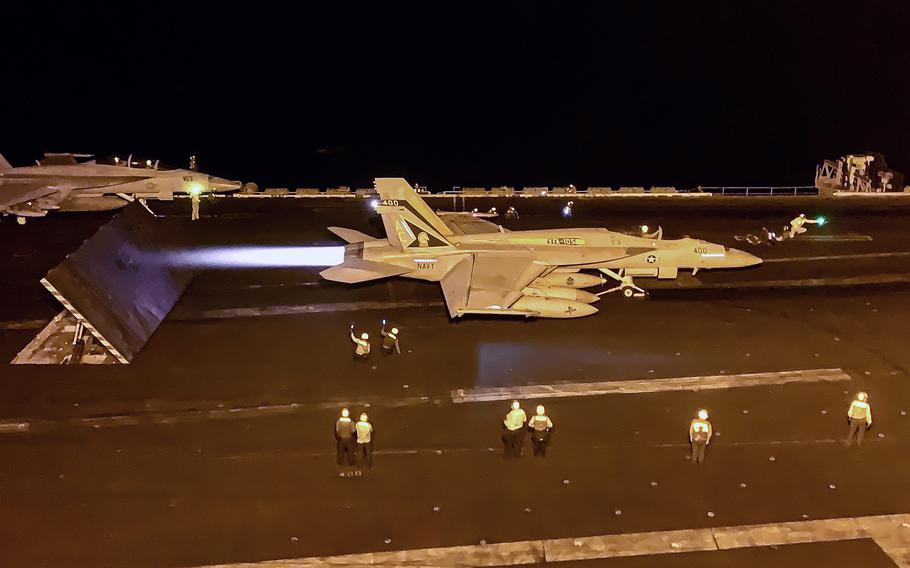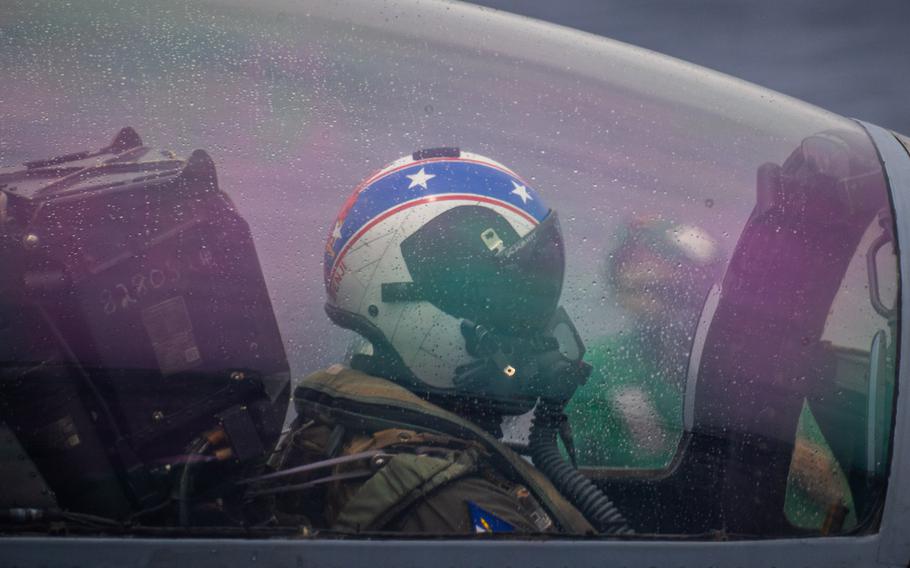
An F/A-18 Super Hornet launches during a night flight in March 2024. The House Committee on Oversight and Government Reform has asked for documents related to a secret Navy study about potential brain injury to pilots. (Alison Bath/Stars and Stripes)
A powerful congressional committee is probing a secret Navy program studying potential traumatic brain injuries suffered by the service’s aviators, which may have led to the recent suicides of at least three Super Hornet pilots.
On Thursday, Rep. James Comer, chairman of the House Committee on Oversight and Government Reform, sent a letter to acting Secretary of the Navy Terence Emmert requesting information and documents related to Project Odin’s Eye, an internal service review of traumatic brain injuries potentially sustained by pilots with the Strike Fighter Tactics Instructor program, popularly known as TOPGUN.
The secret project, “initiated without formal approval from Navy Medical and Air Commands, raises additional questions about the Navy’s knowledge of potential issues and whether it is acting to mitigate these issues in a comprehensive and effective manner,” said Comer, a Republican from Kentucky.
Comer noted that while the service’s efforts to better understand the impacts of high-speed flight on the human brain are understandable, “it is concerning that Navy command may not be fully aware of (the program’s) existence.”
He also informed the Navy that the committee was investigating the service’s efforts “to mitigate possible physiological and psychological effects inflicted on certain naval aviators and flight officers.”
The letter was first reported and posted Thursday by The New York Times.

A pilot prepares for a flight in an F/A-18F Super Hornet on the aircraft carrier USS Carl Vinson, Feb. 4, 2025, in the Indo-Pacific area of operations. The House Committee on Oversight and Government Reform has asked for documents related to a secret Navy study about potential brain injury to pilots. (Nathan Jordan/U.S. Navy)
At issue is the impact on the brain of catapults and arresting gear typically used on aircraft carriers to rapidly accelerate or decelerate aircraft.
Catapults help F/A-18 Super Hornet fighter jets go from zero to at least 190 mph in seconds as they launch from the runway of an aircraft carrier. Arresting gear brings an aircraft traveling at about 150 miles per hour to a complete stop within 320 feet, also within seconds.
Other fixed-wing aircraft that take off from or land on Navy carriers include the E-2 Hawkeye, EA-18G Growler, F-35C Lightning II and C-2 Greyhound.
It’s not clear how the gravitational forces experienced in repeated launches and landings affect the brain. The impact of G-force also is experienced by Navy aviators during missions and in combat.
The Navy has publicly denied the risk of TBI for pilots. But some aviators have reported sudden and unexplained mental health problems, including insomnia, anxiety, depression and PTSD-like symptoms, all of which can be a result of repeated subconcussive brain injuries, according to the Times report.
Three former Super Hornet pilots, all in their 40s, died by suicide within months of one another in 2023 and 2024. Their families said the pilots had symptoms consistent with brain injuries, the newspaper reported separately in December.
Project Odin’s Eye was created in 2024 to look for brain injuries in Navy SEALs and expanded in November to include TOPGUN aviators, the newspaper said.
In the letter, Comer requests that the Navy schedule a briefing with committee staff no later than Feb. 13 to better understand the extent the service has evaluated and addressed physiological and psychological injuries for naval aviators and flight officers.
He also demands that the service submit all documents, communications and drafts of Project Odin’s Eye, along with research protocols, funding information and the names of all Defense Department officials overseeing the project.
The Navy also must submit all command and safety investigations from the past 10 years related to TBIs of all naval aviators and flight officers, among other requested documents and information to be handed over to the committee by Feb. 20.
“While elite and highly trained naval aviators and flight officers understand the high-stress, high-stakes missions they will undergo to safeguard American national security, it is imperative to ensure the warfighter has full and accurate information about health risks and the tools, both mental and physical, to safeguard their health,” Comer said.
bath.alison@stripes.com @alisonbath_